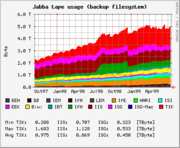RRDtool
From Wikipedia, the free encyclopedia
| Design by | Tobi Oetiker |
|---|---|
| Latest release | 1.3.6 / January 20, 2009 |
| Written in | C |
| License | GNU General Public License |
| Website | http://oss.oetiker.ch/rrdtool/ |
The round-robin database tool RRDtool aims to handle time-series data like network bandwidth, temperatures, CPU load etc. The data gets stored in round-robin database so that system storage footprint remains constant over time.
It also includes tools to extract RRD data in a graphical format.
Tobi Oetiker wrote RRDtool as a replacement for MRTG and licenses it as free software under the terms of the GNU General Public License (GPL).
Bindings exist for Perl, Python, Ruby, Tcl and PHP.
[edit] General data storage
RRDtool assumes time-variable data in intervals of a certain length. This interval, usually called step, is specified upon creation of an RRD file and cannot be changed afterwards. Because data may not always be available at just the right time, RRDtool will automatically interpolate any submitted data to fit its internal time-steps.
The value for a specific step, that has been interpolated, is called a primary data point (PDP). Multiple primary data points may be consolidated according to a consolidation function (CF) to form a consolidated data point (CDP). Typical consolidation functions are average, minimum, maximum.
After the data has been consolidated, the resulting CDP is stored in a round-robin archive (RRA). A round-robin archive stores a fixed amount of CDPs and specifies how many PDPs should be consolidated into one CDP and which CF to use. The total time covered by an RRA can be calculated as follows:
time covered = (#CDPs stored) * (#PDPs per CDP) * step
After this time the archive will "wrap around": the next insertion will overwrite the oldest entry. This behavior is sometimes referred to as "round-robin" and the reason for the program's name.
To cover several timespans and/or use several consolidation functions, an RRD file may contain multiple RRAs. The data retrieval function of RRDtool automatically selects the archive with the highest resolution that still covers the requested timespan. This mechanism is also used by RRDtool's graphing subsystem.
[edit] Other tools that use RRDtool as a DBMS and/or graphing subsystem
- Cacti
- Centreon (Formerly Oreon)
- collectd
- drraw
- Ganglia
- GroundWork Monitor
- JFFNMS
- Lighttpd
- mailgraph
- MRTG
- Munin
- Nfsen
- Observer (software)
- RRD Collector for Windows
- RRDWeather
- Smokeping
- System and Network Monitor
- Torrus
- Webminstats
- YaLiMon
- Zenoss
[edit] External links
| This computer software article is a stub. You can help by expanding it. |


